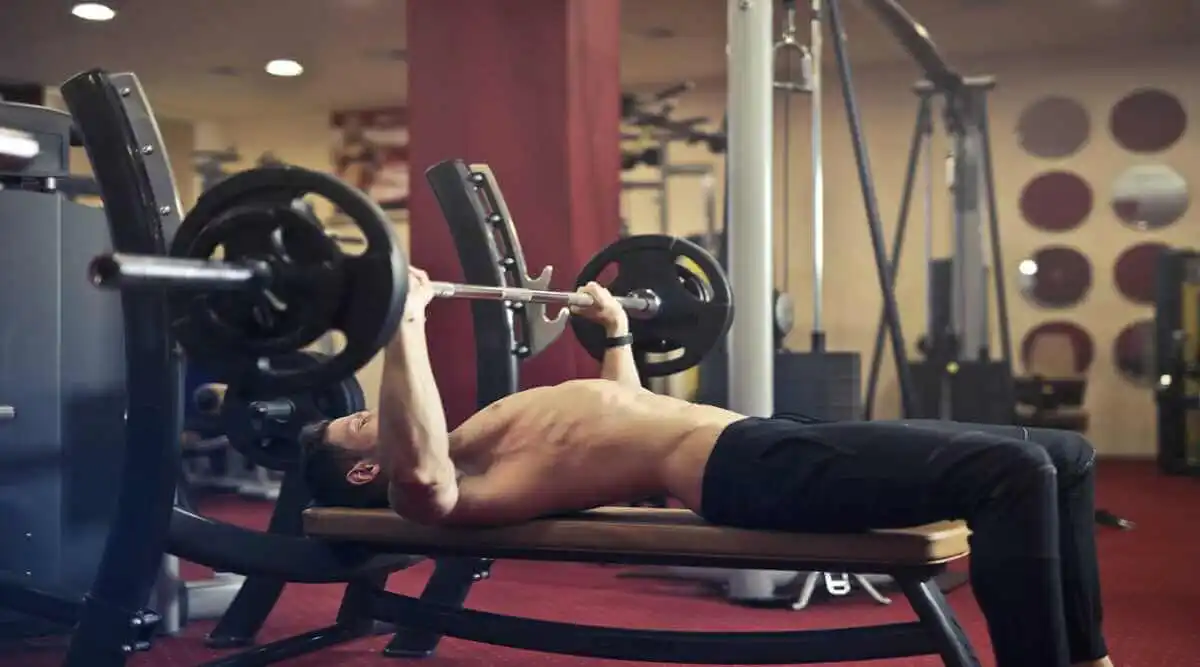People work out with different and particular objectives. Some do it to have a good physical condition while others do it to develop muscle hypertrophy (increase) or simply tone some the muscles in the body.
However, you must be completely sure to choose the correct exercises to meet the planned goals. In that context, many mistakes are made in this matter due to which the several inappropriate exercises that are selected.
Remember that if you do not have experience in this area, you must document yourself and consult a qualified trainer so that they can produce a workout schedule for you.
It is important to know which muscles are worked out by a machine or a compound. So, regarding this article, we’re going to claridy if you can work out biceps on the bench press.
Also, we’re going to give you actionable and proven routines to build bigger biceps.
Does bench press workout biceps?
It is very normal to observe in the Gym or in some outdoor spaces, people making about certain exercises such as the bench press, which is used in the wrong way to work out the biceps. It is important to note that this exercise does not directly work out the biceps. On the contrary, it exercises the pectoral muscles.
Although, in a certain way, the biceps are worked but not directly. So, hypertrophy does not develop nor does direct work occur in this area.
What muscles does the bench press work out?
To clarify this issue, the bench press movement only recruits other secondary muscles such as: the shoulders (from the front) and the triceps from a biomechanical point of view.
The bench press directly exercises the pectoralis major together with the pectoralis minor, including other muscles with antagonistic functions.
In this particular, the latter have the function of generating a reaction contrary to the movement that the agonist muscle is executing, the objective of which is to regulate and especially control the movement.
In the specific case of the “bench press” exercise, the antagonist muscles are the following: the deltoid, the posterior head of the shoulder, the lats and the biceps.
To understand these muscles and movement, let’s take a look at the antagonist pairs of muscles in this useful video.
Definitely, remember that before working on any routine or exercise, the ideal thing is to know what group of muscles you plan to exercise in order to document and advise yourself effectively, and protecting your body from unexpected injuries.
How to exercise biceps for beginners?
For beginners, the workout of biceps should start with basic routines; supplied with a “low” volume of work and with an approach based on progression and training by periods (periodization).
On the other hand, the frequency of the routines will be established at approximately 2 training sessions per week, with at least 2 days of rest, for a period of 3 to 4 months.
Likewise, this approach will be aimed at optimizing the way the exercise is carried out, both in its execution and movement, and in the development of strength.
In this sense, it is important to progress in absolute strength since the objective is to use a low volume for muscle building in the ranges of repetitions to be carried out, which will be made up of 10 to 12 repetitions for each series.
It should be noted that beginners do not require volume or advanced training techniques to build muscle mass, but they do need to have as many fast and slow twitch fibers as possible.
Biceps Workout
Curls are the exercises used to develop the biceps directly. They are performed by flexing the arm appropriately, using different routines using an amount of weight according to the characteristics of the person.
Here are 4 biceps routines that are suitable to perform:
Routine No. 1
Biceps Curl in Standing Position with Straight Bar: Apply 3 to 4 sets of 8 to 10 repetitions with a minute of rest between them.
Routine No. 2
Bench Alternating Dumbbell Curl: 3 to 4 sets of 8 to 10 repetitions, with a minute and a half rest.
Routine No. 3
Wide Grip Curl (open to the width of the shoulders), with the Z Bar – on your feet: apply 3 to 4 series of 10 to 12 repetitions with a minute and a half of rest approximately.
Routine No. 4
Dumbbell Concentrated Curl (Seated): apply two series of 12 to 15 repetitions with a moderate weight that allows you to reach that number of repetitions, plus two minutes of rest between series.
Common mistakes when working out biceps
It is very common to make mistakes in this exercise in terms of movements or incomplete ranges. In this sense, certain types of techniques are required that are specific and adequate to develop biceps.
To avoid mistakes that harm your evolution and progress, pay close attention to the most common mistakes:
Exaggerated flexion at the wrist
The main objective in this particular is to keep the wrists in a comfortable position, but that is effective and neutral each time the repetitions are made.
At the moment the wrist is flexed, when it bends to try to bring the hand closer to the body, two very specific errors occur. First, the extensor muscles of the wrist and forearm are used to initiate the curl badly, causing stress in those areas.
Second, flexing the wrists will shorten the lever the biceps require to work comfortably, thus preventing a more natural movement from taking place.
To remedy this situation, you must maintain a neutral position in both wrists throughout the movement, concentrating on the extension and flexion of the elbow joint.
Exaggerated involvement of the Shoulders
When there is excessive involvement of the shoulders, at the moment of executing the movements of flexion of the elbows, especially when the load is increased or fatigue begins to appear, the result usually appears in the shoulders, therefore the development of the biceps is neglected.
To avoid this, you must concentrate on placing your elbows to the sides and only moving the elbow joint. This condition must be applied to any type of curl, understood as: bars, dumbbells or cables, because the goal of the movement is to isolate the biceps muscle.
Remember that it is possible not to limit yourself to the intervention of the shoulder in each repetition, because the shoulder will eventually gets tired. But the main objective of this exercise is for the biceps to do the corresponding work.
Supination
With this error, the biceps have two very obvious functions, which are: bend the elbows and supinate or turn the palms of the hands up. It is a priority that both functions are performed optimally in each repetition.
To solve this problem, the palms of both hands must be moved towards the ceiling at the beginning of each repetition.
Frequently asked Question
Ideally, work on an incline bench at a 45 degree angle to your feet with a dumbbell, extending your arm on the back with your palm facing up, using a (supine) grip, going up in a way that the positive part of the movement is towards the direction of the shoulder.
In general, it is recommended to perform this exercise 2 to 3 times a week.
Everything will depend on the objective that you have in your routine for this muscle, since, for example: people who seek to do a job to increase their muscle mass considerably should rest for approximately two days because they are small muscles, like the triceps.
On the other hand, the largest muscles such as the back or chest, up to two or three days, are enough to recover from said physical load.
This will depend on the planning and evaluation of the person individually, considering the type of genetics they have, since it is a small muscle group, 3 or 4 exercises for the biceps of four sets of 8 to 10 repetitions each, with maximum breaks of approximately one minute, would suffice.
The approximate general time is two months, depending on important criteria such as your genetics and the type of diet you follow, which must be balanced in terms of: proteins, minerals, carbohydrates, and lipids.
Conclusion
Definitely, the bench press is not the right one to develop the biceps directly. It is used specifically to work the pectoral muscles.
Therefore, to work out the biceps, the exercise called Curl is used, which simply consists of properly bending the arm, and is carried out in different varieties with execution of a certain weight.
It is relevant to clarify that beginners should start with basic routines, where the volume of work is low and progressing with the weight and the number of repetitions.
Apply our routines designed specifically for beginners:
- Biceps Curl in Standing Position with Straight Bar.
- Bench Alternating Dumbbell Curl.
- Wide Grip Curl with the Z Bar.
- Dumbbell Concentrated Curl while seated.
It is also important to bear in mind that the effective work of the biceps will depend on the training focused on developing and stimulating of the fibers in that area since they are small muscles.
Likewise, follow-up must be carried out, in terms of sustainable development and maintenance of muscle gains.
The success in the physical work of a muscle will depend on the dedication, perseverance, motivation and discipline; as well as a good plan.
Leaving time aside, it is necessary and vital to achieve these objectives with serious work and with a proper progression of the training, in relation to a well-defined periodization and an adequate physical load in the training.
The key, together with everything explained above, is to comply with a diet rich in nutrients, which allow muscular development in a benign way without neglecting the proper balance to achieve a healthy body.
Finally, remember to consult a qualified specialist in this area if you have any doubts or queries.

Eudin es un profesional e instructor de fitness certificado certificado con más de 25 años de experiencia. Diseña rutinas de ejercicios y planes de pérdida de peso para personas de diversas edades. Eudin ha dedicado su vida al entrenamiento físico para conseguir grandes resultados no sólo para él sino también para sus estudiantes.




